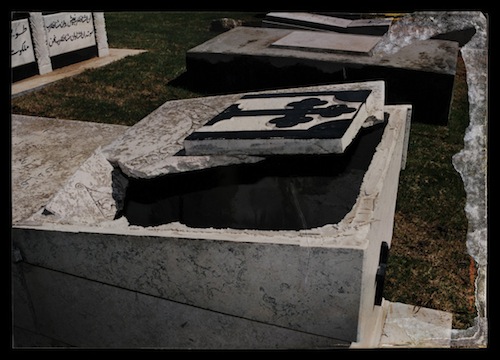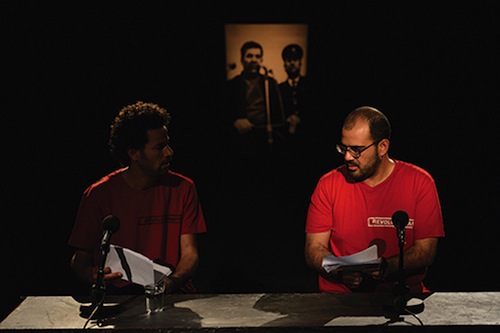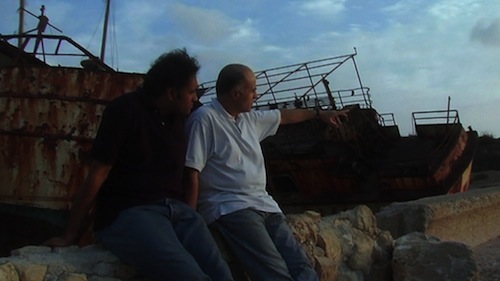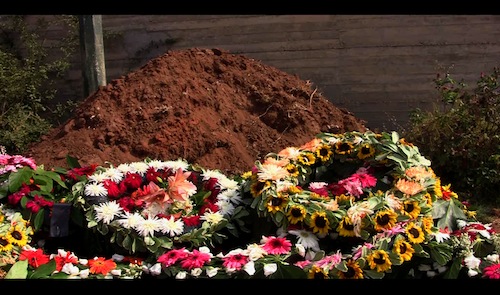When Israel-Palestine is addressed in the context of international exhibition practices, the trend is to quickly categorize artists in terms of national identity. But the contemporary reality on the ground, as well as the history of both Israeli and Palestinian nationalisms, suggests that nationality is a complicated situation. Artists Aissa Deebi, Kamal Aljafari, and Dor Guez all work at the bizarre intersection of nationalisms that the occupation of Palestine has produced. Their work draws from their own personal histories as well as those of the regions in which they grew up.
Aissa Deebi’s film The Trial (2013) is included in the two-person exhibition Otherwise Occupied at the 55th Venice Bienniale, which serves as a provisional Palestinian pavilion. Installed as a two-channel projection, Deebi’s film depicts two actors in a dark room dressed in red T-shirts with the word “REVOLUTIONARY” printed in white across their chests. The Trial is based on a 1973 deposition given by the Israeli-Palestinian poet and intellectual Daud Turki; the actors deliver an impassioned argument that details his Marxist positions. Turki, who grew up in Haifa, was a member of the Revolutionary Communist Alliance-Red Front and had been arrested by Israel for collaborating with the enemy and espionage following a trip to Damascus to allegedly meet with Syrian intelligence.
As the video unfolds, we hear the two actors deliver intersecting monologues that tell of Turki’s history, including his activities within the Israeli Communist Party from which he was expelled in 1963 for his Maoist views and insistence on the Palestinian Right of Return. Turki then joined Matzpen, the Israeli Socialist Organization, which was both anti-Zionist and anti-capitalist. The insistence here on class struggle as opposed to nationalism is remarkable, but Deebi has choreographed this trial—an allusion to the absurdity of Franz Kafka’s eponymous tale—so that the speakers are constantly being interrupted by figures bringing in glasses of water or cups of coffee, loudly setting them on the table. These actions tug at the expected dramatic arc of revolutionary rhetoric, producing a farcical picture of utopian idealism that is at once recalled and refused.
Kamal Aljafari’s film The Roof (2006), which was recently screened at the Sakakini Cultural Center in Ramallah, also addresses the contradictions inherent in Israeli-Palestinian identity but through the lens of autobiography. Aljafari was raised in Ramleh, a town in central Israel with a population of both Arabs and Jews. The Roof presents us with a portrait of his family that combines documentary detail with spare cinematic beauty.
There is a sense of suspended time in this film, where characters often seem to be mourning a disaster, presumably the 1948 Nakba (“catastrophe”), which established Palestinians (such as Aljafari’s family) as citizens in the newly established Israeli state while also treating them as second class members of a Jewish nation. And yet the characters in Aljafari’s film also seem to be waiting for something. In one scene in Jaffa, Aljafari sits and listens to his uncle on the Jaffa coast tell stories of the former glory of this once vital port town. Moored rusted boat hulls appear behind him. One long shot involves Aljafar’s mother looking out the window, another has her sitting on a roof, unfazed by the fall of dusk around her. It reminded me of Paul Chan’s Waiting For Godot, which turned Becket’s tale into a metaphor for a community that waits, to no avail, for help to come from outside to a place ravaged by disaster.
Finally, the work of Dor Guez, which closed last month at the Mosaic Rooms in London, also addresses the complications of a mixed Israeli-Palestinian identity. Guez, is from Lod (formerly Al-Lydd), a town right next to Ramleh, which also expelled the majority of its Palestinian population in 1948. Guez’s video installation, 40 DAYS (2012), chronicles the destroyed gravesites of Lod’s Christian Palestinian cemetery. At one point in the main video projection, we see Guez talking to his grandmother who shows him photographs his grandfather took to prove the graves’ desecration to the police. But the photos have become wet and stuck together. As she tries to show them to her grandson, she rips the imagistic archive in such a way that reflects the violence perpetrated on a marginalized community.

Dor Guez. “40 Days “Scanogram,” 2012. From a series of manipulated ready-mades, 12 archival inkjet prints. 35.4 x 25.6 in.
While there are many similarities that exist in the overlap of these artists’ histories and their respective practices, it would be a mistake to conflate their work. Aissa Deebi teaches at the American University in Cairo. Kamal Aljafari is based in Germany. And Dor Guez lives and works in Tel Aviv. They all show their work internationally, and function both in and outside of regions that often serves as their point of departure. Their practices exist in a diasporic space, a middle zone that reveals the unsettled state that Jalal Toufic calls “The Withdrawal of Tradition Past as Surpassing Disaster.” The disaster of the Nakba has left some things intact, like the remnants of Palestinian communities in Haifa, Ramleh or Lod. But it continues to unfold as the traditions of these communities are constantly under threat. These three artists remind us of these traditions and give us a picture of a condition that is continually under siege.
This post concludes Noah Simblist’s monthlong blog residency.








Pingback: August Blogger-in-Residence | Dorothy Santos | Art21 Blog